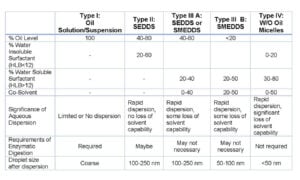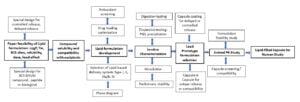Benefits of Lipid-based Delivery Systems in Poorly Soluble Drugs
A growing number of pharmaceutical companies’ drug pipelines are being filled with water-insoluble (BCS II/IV) or low permeable (BCS III/IV) therapeutic entities. Lipid-based drug delivery systems have become an important tool for the formulation development of those compounds. Pharma companies looking to outsource BCS II/V or BCS III/IV drug development need to partner with a contract development and manufacturing organization (CDMO) experienced in the technology to meet time-to-market deadlines and development costs.
Lipid-based drug delivery systems have become a technology of choice because they can enhance the oral bioavailability of drugs by increasing dissolution and solubility by pre-dissolving drugs in lipid carriers, improving drug permeability in the gastrointestinal tract (GI) by inhibition of P-gp and other efflux transporters, bypassing the first-pass metabolism of the drug through the lymphatic absorption processes.
There are other benefits to lipid-based drug delivery systems. For one, they have the potential to decrease the food-effect and increase reproducibility of the pharmacokinetic (PK) profile of orally administered drugs by reducing erratic absorption.
Delivery System Composition
A lipid-based drug delivery system typically is composed of a lipid carrier, co-solvent, surfactants, and co-surfactants. It can be classified in two ways, depending on the surfactant level. A microemulsion is a thermodynamic stable lipid concentrate with a high level of surfactant, while a nano-emulsion is a pre-formed nano-system caused by high-energy inputs and is kinetic stable in the aqueous phase.
Lipid-based drug delivery systems can be also characterized into five categories shown in Figure 1. The two most popular systems used for insoluble drugs are Type II/IIIA: Self-Emulsifying Drug Delivery Systems (SEDDS) and Type IIIB: Self-Microemulsifying Drug Delivery Systems (SMEDDS), which forms thermodynamically stable microemulsions.

Figure 1. Classification of Lipid-based Drug Delivery System*
* adaption from Pouton, C.W et al., Eur. J. Pharm. Sci. 2000, 2006, Adv Drug Deliv Rev., 60: 673-91, 2008
Successful formulation development of lipid-based dosage forms requires an experienced team with a thorough understanding of compound properties, as well as a well-defined quality-by-design and development process. Figure 2 shows the comprehensive method employed by Ascendia Pharmaceuticals.

Figure 2: Ascendia quality-by-design and development process.
Pharmaceutical Profiles Most Benefitted
Lipid-based dosage forms bring the greatest benefits to lipophilic, insoluble drugs with poor bioavailability through GI absorption (BCS II) and a strong food effect. They can also improve the oral bioavailability of therapeutic entities, which are subject to efflux, high first-pass, low stability in GI fluids, or low permeability.
Two delivery methods are commonly used for intestine/colon drugs. One is a delayed release for gastric irritation. The second is sustained release to achieve a prolonged PK profile by utilizing solid/semisolid lipid materials or coating of capsules with insoluble or enteric polymer.
Drug-excipient Solubility and Compatibility
Lipidic excipients can be divided into four categories:
- Oils, such as long-chain triglycerides (LCTs), medium chain triglycerides (MCTs), mixture of mono-, di-, and tri-glycerides, and fatty acids
- Water-insoluble surfactants: HLB < 12
- Water-soluble surfactants: HLB >/= 12
- Cosolvents
The development team will select approximately five or six oils, surfactants, co-surfactants, and cosolvents in various combinations. Each will be evaluated by drug solubility and compatibility. For compounds with poor permeability or efflux potential, the excipients that potentially can inhibit enzymatic efflux, increase tight junction permeability, or enhance lymphatic absorption can be added into the solubility screening assessment. Antioxidants may be also introduced to protect the active drug from degradation caused by incompatibility between drug and excipients.
This process highlights the importance of the CDMO team on the project. They must have the expertise and insight to form all the possible combinations and conduct a thorough evaluation. The analysis will leverage the experience of the team to make the proper formulation decision.
Lipid Formulation Development, Characterization
The success of lipid-based formulations depends on the understanding of the compound’s physical-chemical and biopharmaceutical properties. For insoluble compounds with solubility- or dissolution-limited absorption processes, Type II-IV formulations could significantly improve bioavailability by reducing the droplet size to the nano levels. For example, cyclosporine A lipid dosage form, Neoral®, is a Type III formulation that has a higher bioavailability than its Type II formulation (Sandimmune®).
Smaller droplet size does not always guarantee better in-vivo performance. For example, Type I formulation of a lipophilic compound may promote lymphatic absorption and perform best in vivo. This contrasts a SMEDDS formulation whose bioavailability may not improve due to precipitation of compound in the GI tract.
The CDMO team will conduct an initial excipients screening study. The results will dictate the combination of excipients, solvents, and solubilizers developed to enhance drug loading. Miscibility of excipients should be assessed using a physical stability study. In some cases, a design of experiments (DOE) method can be utilized to screen antioxidants and stabilizers, if the compound’s degradation in formulations is significant. The construction of phase diagrams is valuable for optimizing self-emulsifying lipidic formulations to best define the boundary of region where microemulsions form.
Type I formulations consisting of single oil or oil mixtures require enzymatic digestion to be dispersed into oil droplet or micelles. Type II-III can be dispersed by itself in the aqueous medium into emulsion of different sizes with or without the help from enzymes due to utilization of surfactants. Type IV utilizes surfactants, and co-solvents without lipid oils can form micelles of <50 nm. An experienced team will recognize the potential risk of compound precipitation in the GI tract for Type II-IV formulations and deploy an in vitro dispersion and in vitro dissolution in simulated GI fluids during formulation screening and prior to animal studies.
Dosage Form Development
A lead prototype formulation can be selected for further development after careful analysis of the stability study and animal PK results. To provide a dosage form that is commercially viable and convenient for human consumption, the lipid-based formulation can be filled into capsules and further packed into bottles or blisters. Hard capsules are frequently chosen for lipid-based formulations at the early stage of clinical development because they can be used from early- to commercial-stage of development. They also offer different options for trade dress.
Studies should be conducted to select the capsule that is most compatible with the formulation, has high filling/banding process tolerance, and has excellent shelf-life stability. The capsules also need to be physically strong enough during the coating process, in case it will be coated with enteric polymers or sustained-release polymers to achieve delayed release into the lower GI tract.
Learn More
Lipid-based drug delivery methods enhance solubility/bioavailability and dosage manufacturing flexibility. Pharma companies who partner with a CDMO that specializes in poorly soluble molecules using GRAS material platforms, like Ascendia, can reap distinct advantages. Contact us to find out how we can help in your drug development.

